Organizing Principles and Organizational Structure at Orange Egypt
VerifiedAdded on 2022/05/02
|5
|2144
|30
Report
AI Summary
This report examines the organizing principles and organizational structure of Orange Egypt, a telecommunications company. It begins with an introduction to the core concepts of organizing, including task allocation, delegation of authority, and coordination of efforts to achieve organizational objectives. The report then provides an overview of Orange Egypt, detailing its history, business model, and its commitment to employee development and customer satisfaction. The analysis focuses on how Orange Egypt utilizes both functional and divisional strategies, emphasizing its hierarchical structure and its approach to communication across departments. It also highlights the company's values, including equality, empowerment, and diversity, and how these values are integrated into its workplace culture. The report concludes by summarizing the key findings and emphasizing Orange Egypt's focus on strategic planning and its recognition as a leading employer in Egypt and Africa. The appendix provides additional insights on strategic planning, differentiating between long-term and short-term strategic goals.
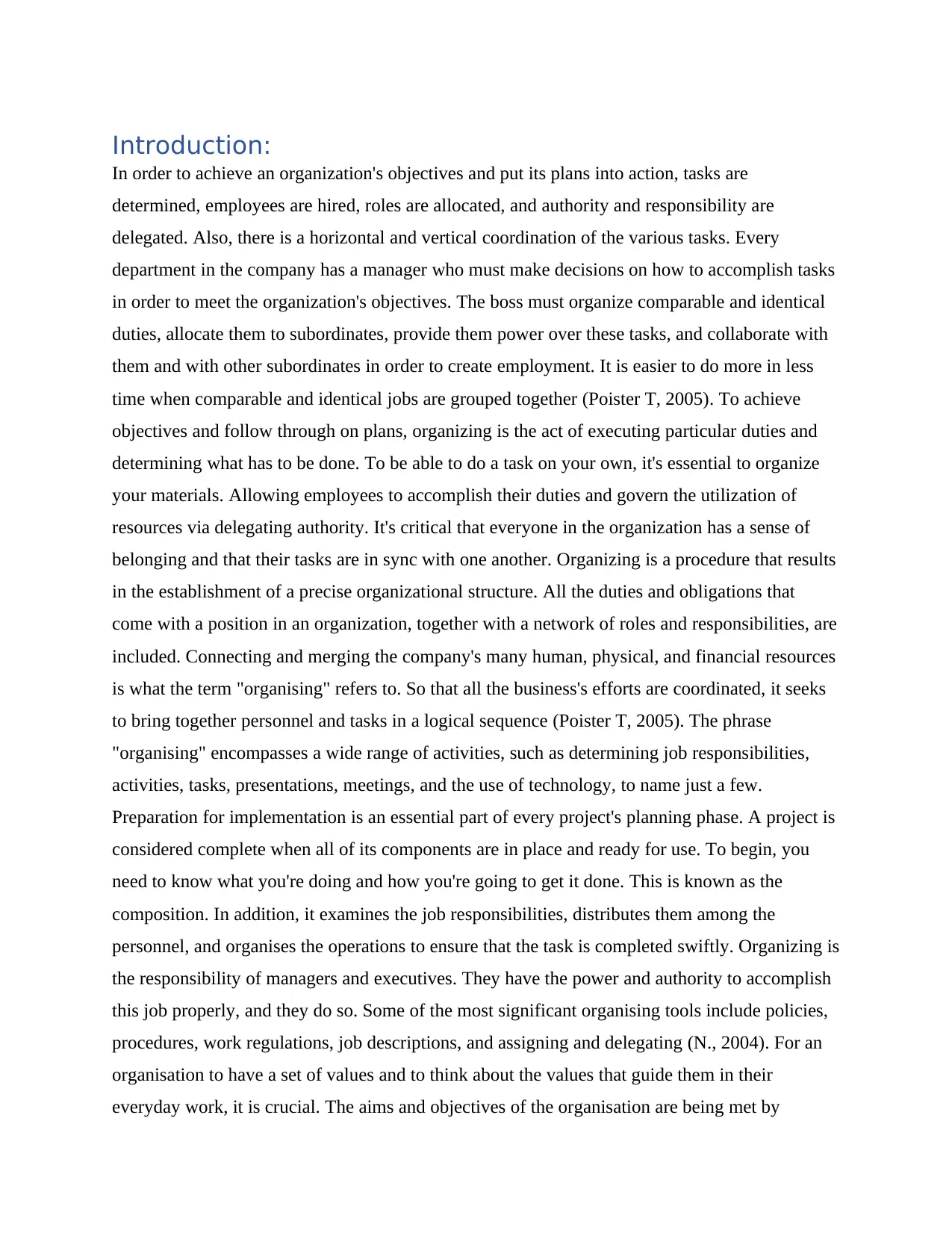
Introduction:
In order to achieve an organization's objectives and put its plans into action, tasks are
determined, employees are hired, roles are allocated, and authority and responsibility are
delegated. Also, there is a horizontal and vertical coordination of the various tasks. Every
department in the company has a manager who must make decisions on how to accomplish tasks
in order to meet the organization's objectives. The boss must organize comparable and identical
duties, allocate them to subordinates, provide them power over these tasks, and collaborate with
them and with other subordinates in order to create employment. It is easier to do more in less
time when comparable and identical jobs are grouped together (Poister T, 2005). To achieve
objectives and follow through on plans, organizing is the act of executing particular duties and
determining what has to be done. To be able to do a task on your own, it's essential to organize
your materials. Allowing employees to accomplish their duties and govern the utilization of
resources via delegating authority. It's critical that everyone in the organization has a sense of
belonging and that their tasks are in sync with one another. Organizing is a procedure that results
in the establishment of a precise organizational structure. All the duties and obligations that
come with a position in an organization, together with a network of roles and responsibilities, are
included. Connecting and merging the company's many human, physical, and financial resources
is what the term "organising" refers to. So that all the business's efforts are coordinated, it seeks
to bring together personnel and tasks in a logical sequence (Poister T, 2005). The phrase
"organising" encompasses a wide range of activities, such as determining job responsibilities,
activities, tasks, presentations, meetings, and the use of technology, to name just a few.
Preparation for implementation is an essential part of every project's planning phase. A project is
considered complete when all of its components are in place and ready for use. To begin, you
need to know what you're doing and how you're going to get it done. This is known as the
composition. In addition, it examines the job responsibilities, distributes them among the
personnel, and organises the operations to ensure that the task is completed swiftly. Organizing is
the responsibility of managers and executives. They have the power and authority to accomplish
this job properly, and they do so. Some of the most significant organising tools include policies,
procedures, work regulations, job descriptions, and assigning and delegating (N., 2004). For an
organisation to have a set of values and to think about the values that guide them in their
everyday work, it is crucial. The aims and objectives of the organisation are being met by
In order to achieve an organization's objectives and put its plans into action, tasks are
determined, employees are hired, roles are allocated, and authority and responsibility are
delegated. Also, there is a horizontal and vertical coordination of the various tasks. Every
department in the company has a manager who must make decisions on how to accomplish tasks
in order to meet the organization's objectives. The boss must organize comparable and identical
duties, allocate them to subordinates, provide them power over these tasks, and collaborate with
them and with other subordinates in order to create employment. It is easier to do more in less
time when comparable and identical jobs are grouped together (Poister T, 2005). To achieve
objectives and follow through on plans, organizing is the act of executing particular duties and
determining what has to be done. To be able to do a task on your own, it's essential to organize
your materials. Allowing employees to accomplish their duties and govern the utilization of
resources via delegating authority. It's critical that everyone in the organization has a sense of
belonging and that their tasks are in sync with one another. Organizing is a procedure that results
in the establishment of a precise organizational structure. All the duties and obligations that
come with a position in an organization, together with a network of roles and responsibilities, are
included. Connecting and merging the company's many human, physical, and financial resources
is what the term "organising" refers to. So that all the business's efforts are coordinated, it seeks
to bring together personnel and tasks in a logical sequence (Poister T, 2005). The phrase
"organising" encompasses a wide range of activities, such as determining job responsibilities,
activities, tasks, presentations, meetings, and the use of technology, to name just a few.
Preparation for implementation is an essential part of every project's planning phase. A project is
considered complete when all of its components are in place and ready for use. To begin, you
need to know what you're doing and how you're going to get it done. This is known as the
composition. In addition, it examines the job responsibilities, distributes them among the
personnel, and organises the operations to ensure that the task is completed swiftly. Organizing is
the responsibility of managers and executives. They have the power and authority to accomplish
this job properly, and they do so. Some of the most significant organising tools include policies,
procedures, work regulations, job descriptions, and assigning and delegating (N., 2004). For an
organisation to have a set of values and to think about the values that guide them in their
everyday work, it is crucial. The aims and objectives of the organisation are being met by
Paraphrase This Document
Need a fresh take? Get an instant paraphrase of this document with our AI Paraphraser
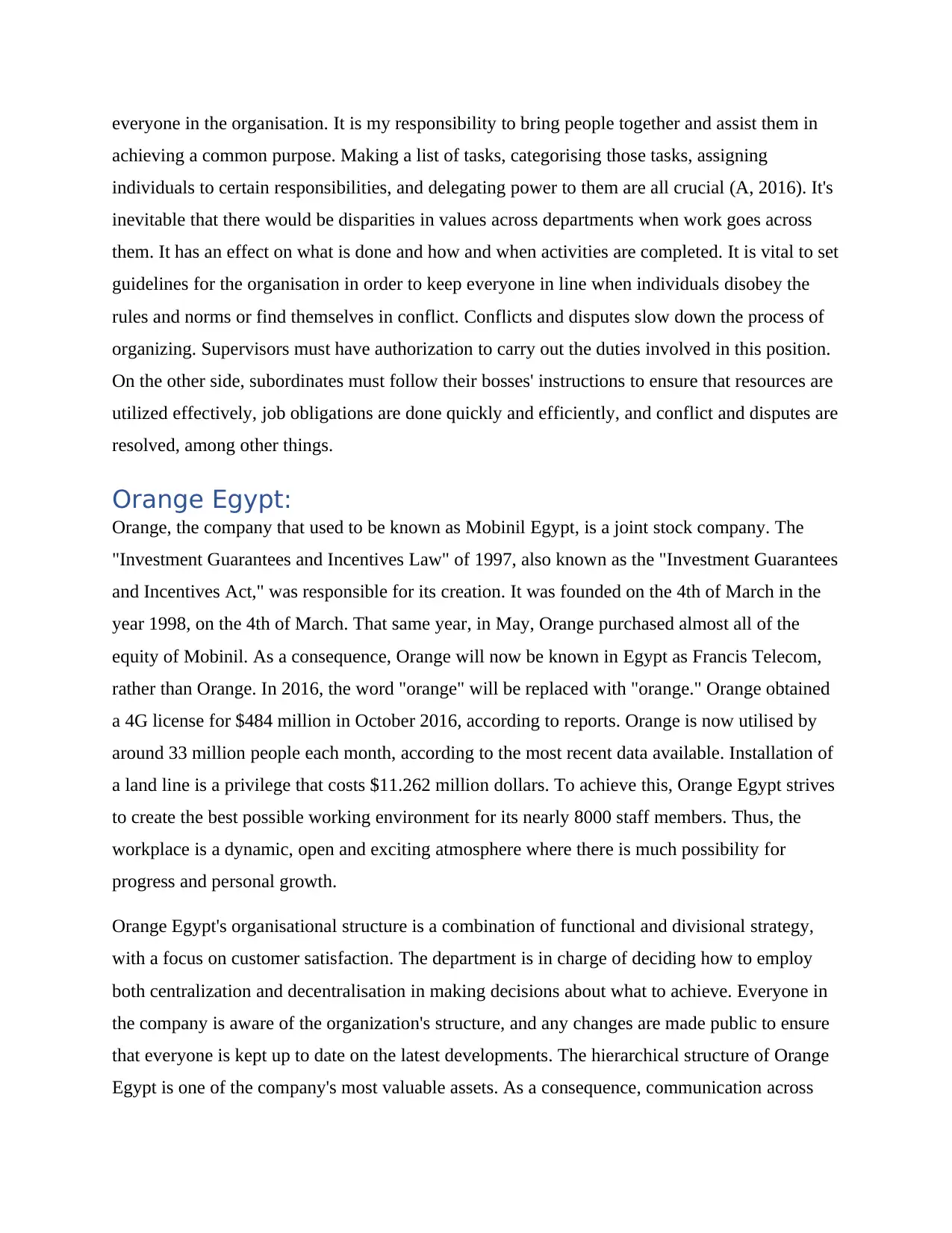
everyone in the organisation. It is my responsibility to bring people together and assist them in
achieving a common purpose. Making a list of tasks, categorising those tasks, assigning
individuals to certain responsibilities, and delegating power to them are all crucial (A, 2016). It's
inevitable that there would be disparities in values across departments when work goes across
them. It has an effect on what is done and how and when activities are completed. It is vital to set
guidelines for the organisation in order to keep everyone in line when individuals disobey the
rules and norms or find themselves in conflict. Conflicts and disputes slow down the process of
organizing. Supervisors must have authorization to carry out the duties involved in this position.
On the other side, subordinates must follow their bosses' instructions to ensure that resources are
utilized effectively, job obligations are done quickly and efficiently, and conflict and disputes are
resolved, among other things.
Orange Egypt:
Orange, the company that used to be known as Mobinil Egypt, is a joint stock company. The
"Investment Guarantees and Incentives Law" of 1997, also known as the "Investment Guarantees
and Incentives Act," was responsible for its creation. It was founded on the 4th of March in the
year 1998, on the 4th of March. That same year, in May, Orange purchased almost all of the
equity of Mobinil. As a consequence, Orange will now be known in Egypt as Francis Telecom,
rather than Orange. In 2016, the word "orange" will be replaced with "orange." Orange obtained
a 4G license for $484 million in October 2016, according to reports. Orange is now utilised by
around 33 million people each month, according to the most recent data available. Installation of
a land line is a privilege that costs $11.262 million dollars. To achieve this, Orange Egypt strives
to create the best possible working environment for its nearly 8000 staff members. Thus, the
workplace is a dynamic, open and exciting atmosphere where there is much possibility for
progress and personal growth.
Orange Egypt's organisational structure is a combination of functional and divisional strategy,
with a focus on customer satisfaction. The department is in charge of deciding how to employ
both centralization and decentralisation in making decisions about what to achieve. Everyone in
the company is aware of the organization's structure, and any changes are made public to ensure
that everyone is kept up to date on the latest developments. The hierarchical structure of Orange
Egypt is one of the company's most valuable assets. As a consequence, communication across
achieving a common purpose. Making a list of tasks, categorising those tasks, assigning
individuals to certain responsibilities, and delegating power to them are all crucial (A, 2016). It's
inevitable that there would be disparities in values across departments when work goes across
them. It has an effect on what is done and how and when activities are completed. It is vital to set
guidelines for the organisation in order to keep everyone in line when individuals disobey the
rules and norms or find themselves in conflict. Conflicts and disputes slow down the process of
organizing. Supervisors must have authorization to carry out the duties involved in this position.
On the other side, subordinates must follow their bosses' instructions to ensure that resources are
utilized effectively, job obligations are done quickly and efficiently, and conflict and disputes are
resolved, among other things.
Orange Egypt:
Orange, the company that used to be known as Mobinil Egypt, is a joint stock company. The
"Investment Guarantees and Incentives Law" of 1997, also known as the "Investment Guarantees
and Incentives Act," was responsible for its creation. It was founded on the 4th of March in the
year 1998, on the 4th of March. That same year, in May, Orange purchased almost all of the
equity of Mobinil. As a consequence, Orange will now be known in Egypt as Francis Telecom,
rather than Orange. In 2016, the word "orange" will be replaced with "orange." Orange obtained
a 4G license for $484 million in October 2016, according to reports. Orange is now utilised by
around 33 million people each month, according to the most recent data available. Installation of
a land line is a privilege that costs $11.262 million dollars. To achieve this, Orange Egypt strives
to create the best possible working environment for its nearly 8000 staff members. Thus, the
workplace is a dynamic, open and exciting atmosphere where there is much possibility for
progress and personal growth.
Orange Egypt's organisational structure is a combination of functional and divisional strategy,
with a focus on customer satisfaction. The department is in charge of deciding how to employ
both centralization and decentralisation in making decisions about what to achieve. Everyone in
the company is aware of the organization's structure, and any changes are made public to ensure
that everyone is kept up to date on the latest developments. The hierarchical structure of Orange
Egypt is one of the company's most valuable assets. As a consequence, communication across
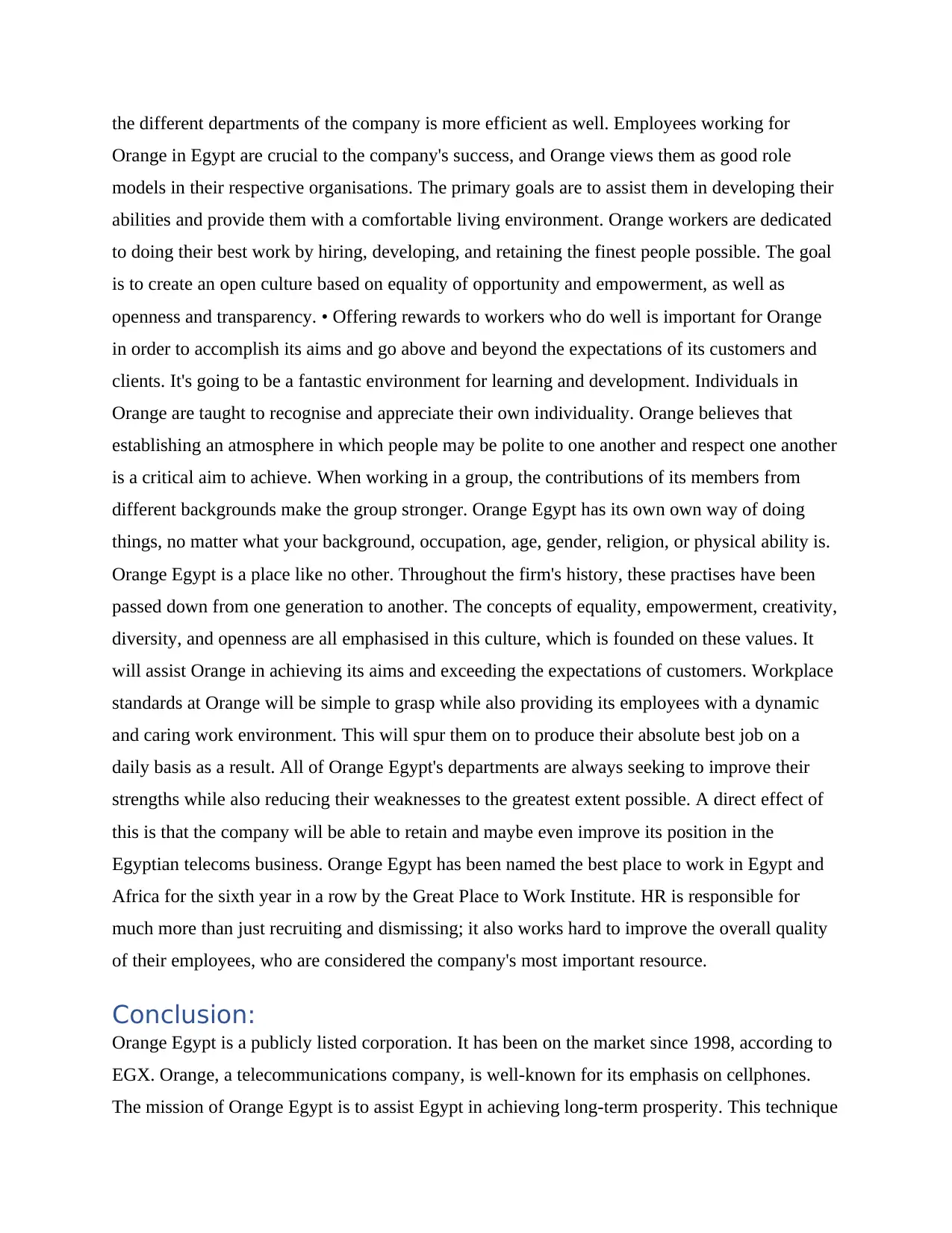
the different departments of the company is more efficient as well. Employees working for
Orange in Egypt are crucial to the company's success, and Orange views them as good role
models in their respective organisations. The primary goals are to assist them in developing their
abilities and provide them with a comfortable living environment. Orange workers are dedicated
to doing their best work by hiring, developing, and retaining the finest people possible. The goal
is to create an open culture based on equality of opportunity and empowerment, as well as
openness and transparency. • Offering rewards to workers who do well is important for Orange
in order to accomplish its aims and go above and beyond the expectations of its customers and
clients. It's going to be a fantastic environment for learning and development. Individuals in
Orange are taught to recognise and appreciate their own individuality. Orange believes that
establishing an atmosphere in which people may be polite to one another and respect one another
is a critical aim to achieve. When working in a group, the contributions of its members from
different backgrounds make the group stronger. Orange Egypt has its own own way of doing
things, no matter what your background, occupation, age, gender, religion, or physical ability is.
Orange Egypt is a place like no other. Throughout the firm's history, these practises have been
passed down from one generation to another. The concepts of equality, empowerment, creativity,
diversity, and openness are all emphasised in this culture, which is founded on these values. It
will assist Orange in achieving its aims and exceeding the expectations of customers. Workplace
standards at Orange will be simple to grasp while also providing its employees with a dynamic
and caring work environment. This will spur them on to produce their absolute best job on a
daily basis as a result. All of Orange Egypt's departments are always seeking to improve their
strengths while also reducing their weaknesses to the greatest extent possible. A direct effect of
this is that the company will be able to retain and maybe even improve its position in the
Egyptian telecoms business. Orange Egypt has been named the best place to work in Egypt and
Africa for the sixth year in a row by the Great Place to Work Institute. HR is responsible for
much more than just recruiting and dismissing; it also works hard to improve the overall quality
of their employees, who are considered the company's most important resource.
Conclusion:
Orange Egypt is a publicly listed corporation. It has been on the market since 1998, according to
EGX. Orange, a telecommunications company, is well-known for its emphasis on cellphones.
The mission of Orange Egypt is to assist Egypt in achieving long-term prosperity. This technique
Orange in Egypt are crucial to the company's success, and Orange views them as good role
models in their respective organisations. The primary goals are to assist them in developing their
abilities and provide them with a comfortable living environment. Orange workers are dedicated
to doing their best work by hiring, developing, and retaining the finest people possible. The goal
is to create an open culture based on equality of opportunity and empowerment, as well as
openness and transparency. • Offering rewards to workers who do well is important for Orange
in order to accomplish its aims and go above and beyond the expectations of its customers and
clients. It's going to be a fantastic environment for learning and development. Individuals in
Orange are taught to recognise and appreciate their own individuality. Orange believes that
establishing an atmosphere in which people may be polite to one another and respect one another
is a critical aim to achieve. When working in a group, the contributions of its members from
different backgrounds make the group stronger. Orange Egypt has its own own way of doing
things, no matter what your background, occupation, age, gender, religion, or physical ability is.
Orange Egypt is a place like no other. Throughout the firm's history, these practises have been
passed down from one generation to another. The concepts of equality, empowerment, creativity,
diversity, and openness are all emphasised in this culture, which is founded on these values. It
will assist Orange in achieving its aims and exceeding the expectations of customers. Workplace
standards at Orange will be simple to grasp while also providing its employees with a dynamic
and caring work environment. This will spur them on to produce their absolute best job on a
daily basis as a result. All of Orange Egypt's departments are always seeking to improve their
strengths while also reducing their weaknesses to the greatest extent possible. A direct effect of
this is that the company will be able to retain and maybe even improve its position in the
Egyptian telecoms business. Orange Egypt has been named the best place to work in Egypt and
Africa for the sixth year in a row by the Great Place to Work Institute. HR is responsible for
much more than just recruiting and dismissing; it also works hard to improve the overall quality
of their employees, who are considered the company's most important resource.
Conclusion:
Orange Egypt is a publicly listed corporation. It has been on the market since 1998, according to
EGX. Orange, a telecommunications company, is well-known for its emphasis on cellphones.
The mission of Orange Egypt is to assist Egypt in achieving long-term prosperity. This technique
⊘ This is a preview!⊘
Do you want full access?
Subscribe today to unlock all pages.

Trusted by 1+ million students worldwide
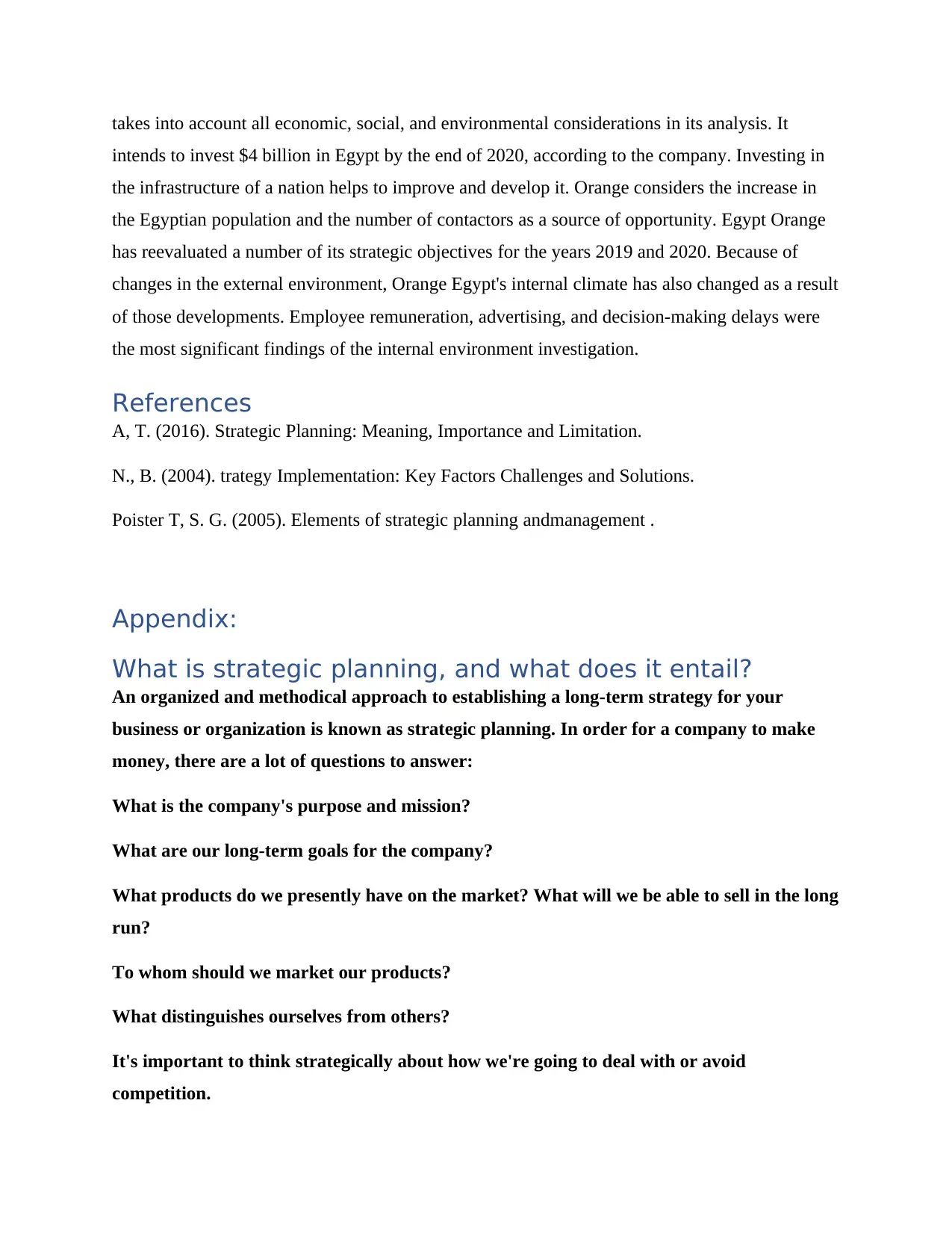
takes into account all economic, social, and environmental considerations in its analysis. It
intends to invest $4 billion in Egypt by the end of 2020, according to the company. Investing in
the infrastructure of a nation helps to improve and develop it. Orange considers the increase in
the Egyptian population and the number of contactors as a source of opportunity. Egypt Orange
has reevaluated a number of its strategic objectives for the years 2019 and 2020. Because of
changes in the external environment, Orange Egypt's internal climate has also changed as a result
of those developments. Employee remuneration, advertising, and decision-making delays were
the most significant findings of the internal environment investigation.
References
A, T. (2016). Strategic Planning: Meaning, Importance and Limitation.
N., B. (2004). trategy Implementation: Key Factors Challenges and Solutions.
Poister T, S. G. (2005). Elements of strategic planning andmanagement .
Appendix:
What is strategic planning, and what does it entail?
An organized and methodical approach to establishing a long-term strategy for your
business or organization is known as strategic planning. In order for a company to make
money, there are a lot of questions to answer:
What is the company's purpose and mission?
What are our long-term goals for the company?
What products do we presently have on the market? What will we be able to sell in the long
run?
To whom should we market our products?
What distinguishes ourselves from others?
It's important to think strategically about how we're going to deal with or avoid
competition.
intends to invest $4 billion in Egypt by the end of 2020, according to the company. Investing in
the infrastructure of a nation helps to improve and develop it. Orange considers the increase in
the Egyptian population and the number of contactors as a source of opportunity. Egypt Orange
has reevaluated a number of its strategic objectives for the years 2019 and 2020. Because of
changes in the external environment, Orange Egypt's internal climate has also changed as a result
of those developments. Employee remuneration, advertising, and decision-making delays were
the most significant findings of the internal environment investigation.
References
A, T. (2016). Strategic Planning: Meaning, Importance and Limitation.
N., B. (2004). trategy Implementation: Key Factors Challenges and Solutions.
Poister T, S. G. (2005). Elements of strategic planning andmanagement .
Appendix:
What is strategic planning, and what does it entail?
An organized and methodical approach to establishing a long-term strategy for your
business or organization is known as strategic planning. In order for a company to make
money, there are a lot of questions to answer:
What is the company's purpose and mission?
What are our long-term goals for the company?
What products do we presently have on the market? What will we be able to sell in the long
run?
To whom should we market our products?
What distinguishes ourselves from others?
It's important to think strategically about how we're going to deal with or avoid
competition.
Paraphrase This Document
Need a fresh take? Get an instant paraphrase of this document with our AI Paraphraser
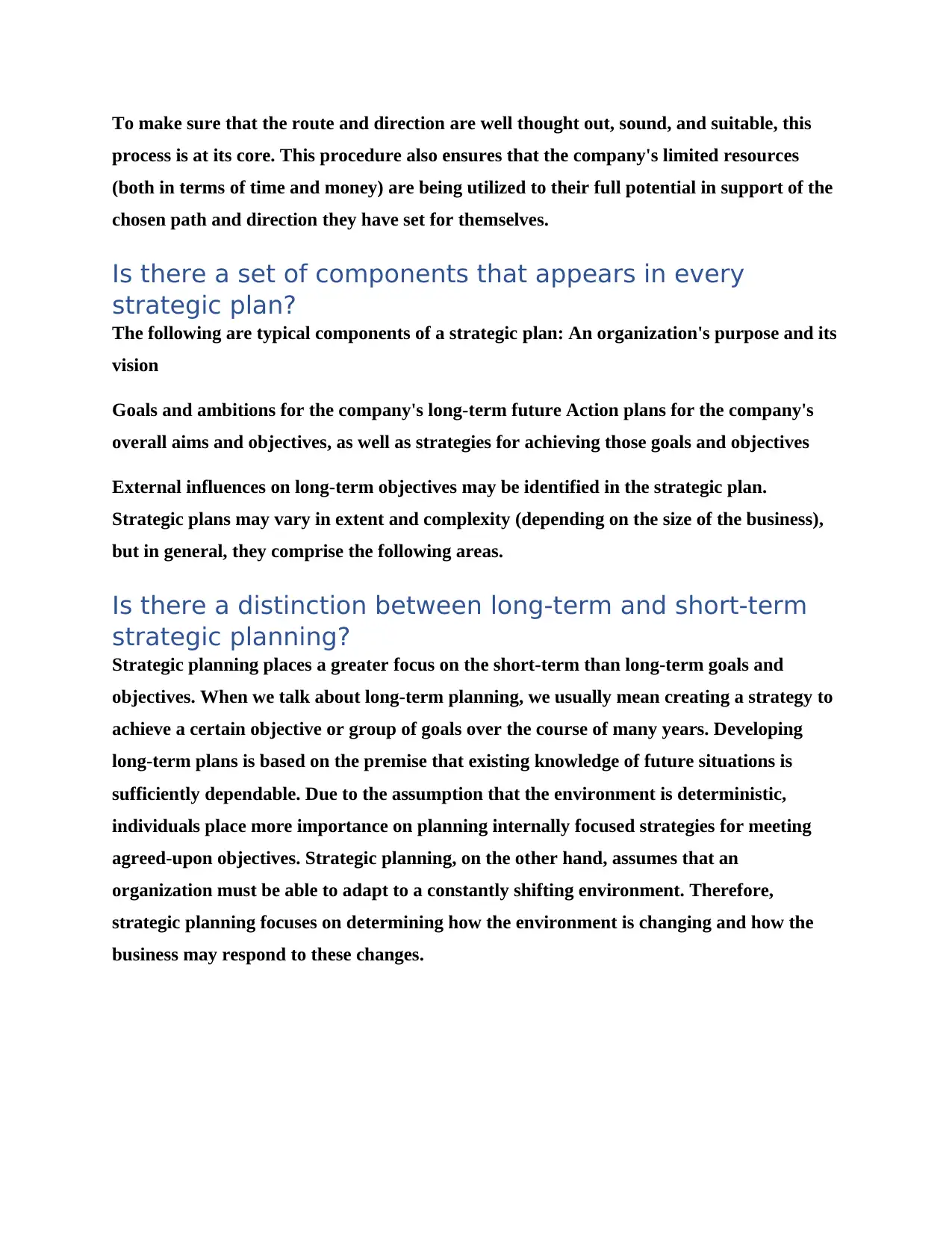
To make sure that the route and direction are well thought out, sound, and suitable, this
process is at its core. This procedure also ensures that the company's limited resources
(both in terms of time and money) are being utilized to their full potential in support of the
chosen path and direction they have set for themselves.
Is there a set of components that appears in every
strategic plan?
The following are typical components of a strategic plan: An organization's purpose and its
vision
Goals and ambitions for the company's long-term future Action plans for the company's
overall aims and objectives, as well as strategies for achieving those goals and objectives
External influences on long-term objectives may be identified in the strategic plan.
Strategic plans may vary in extent and complexity (depending on the size of the business),
but in general, they comprise the following areas.
Is there a distinction between long-term and short-term
strategic planning?
Strategic planning places a greater focus on the short-term than long-term goals and
objectives. When we talk about long-term planning, we usually mean creating a strategy to
achieve a certain objective or group of goals over the course of many years. Developing
long-term plans is based on the premise that existing knowledge of future situations is
sufficiently dependable. Due to the assumption that the environment is deterministic,
individuals place more importance on planning internally focused strategies for meeting
agreed-upon objectives. Strategic planning, on the other hand, assumes that an
organization must be able to adapt to a constantly shifting environment. Therefore,
strategic planning focuses on determining how the environment is changing and how the
business may respond to these changes.
process is at its core. This procedure also ensures that the company's limited resources
(both in terms of time and money) are being utilized to their full potential in support of the
chosen path and direction they have set for themselves.
Is there a set of components that appears in every
strategic plan?
The following are typical components of a strategic plan: An organization's purpose and its
vision
Goals and ambitions for the company's long-term future Action plans for the company's
overall aims and objectives, as well as strategies for achieving those goals and objectives
External influences on long-term objectives may be identified in the strategic plan.
Strategic plans may vary in extent and complexity (depending on the size of the business),
but in general, they comprise the following areas.
Is there a distinction between long-term and short-term
strategic planning?
Strategic planning places a greater focus on the short-term than long-term goals and
objectives. When we talk about long-term planning, we usually mean creating a strategy to
achieve a certain objective or group of goals over the course of many years. Developing
long-term plans is based on the premise that existing knowledge of future situations is
sufficiently dependable. Due to the assumption that the environment is deterministic,
individuals place more importance on planning internally focused strategies for meeting
agreed-upon objectives. Strategic planning, on the other hand, assumes that an
organization must be able to adapt to a constantly shifting environment. Therefore,
strategic planning focuses on determining how the environment is changing and how the
business may respond to these changes.
1 out of 5
Related Documents
Your All-in-One AI-Powered Toolkit for Academic Success.
+13062052269
info@desklib.com
Available 24*7 on WhatsApp / Email
![[object Object]](/_next/static/media/star-bottom.7253800d.svg)
Unlock your academic potential
Copyright © 2020–2025 A2Z Services. All Rights Reserved. Developed and managed by ZUCOL.





